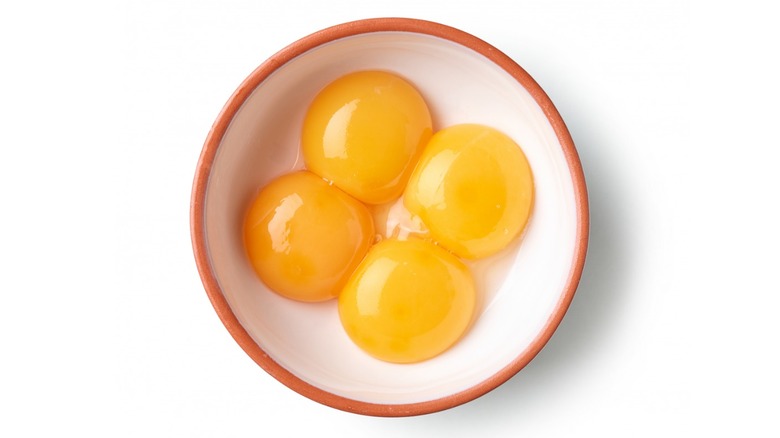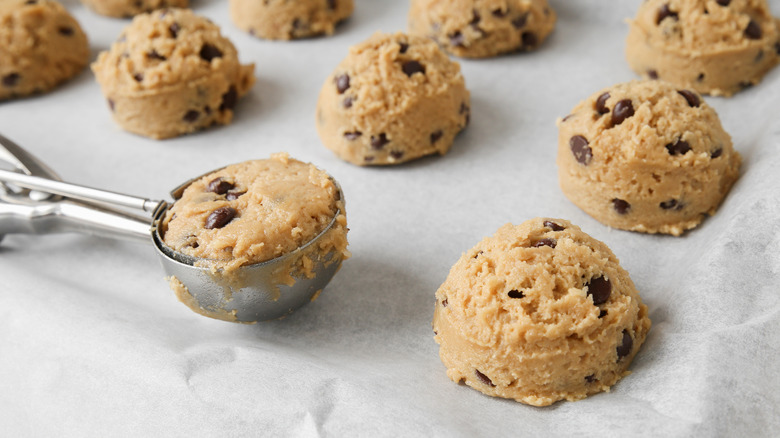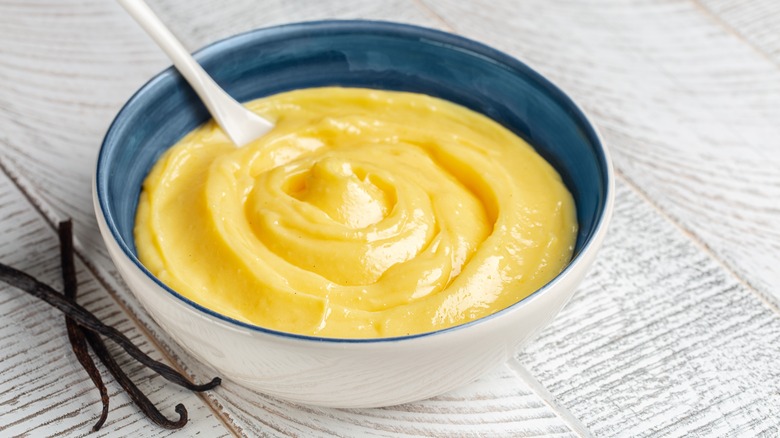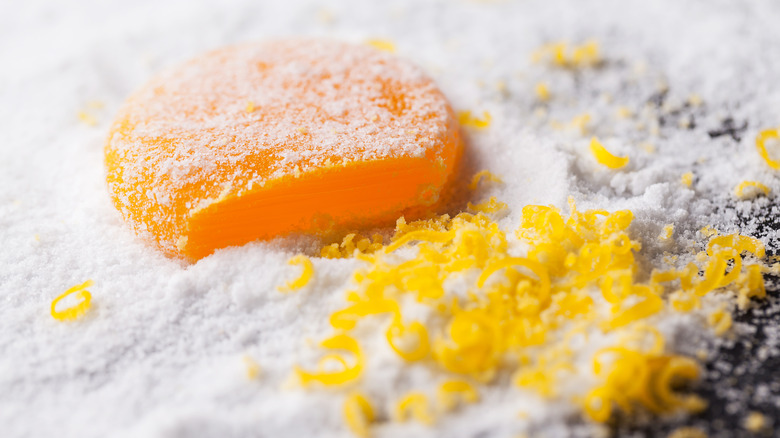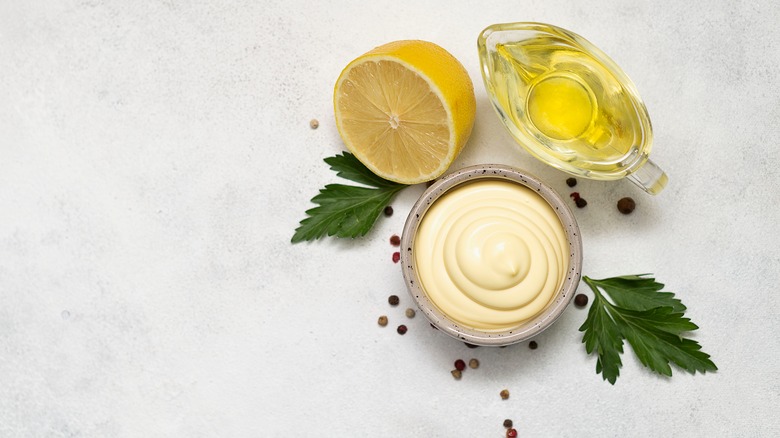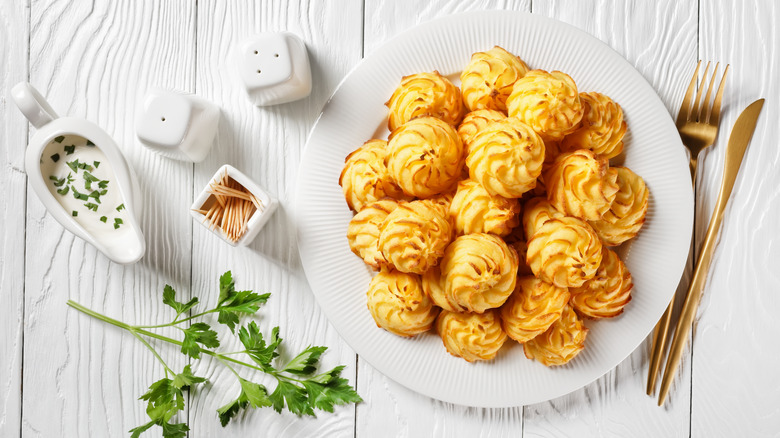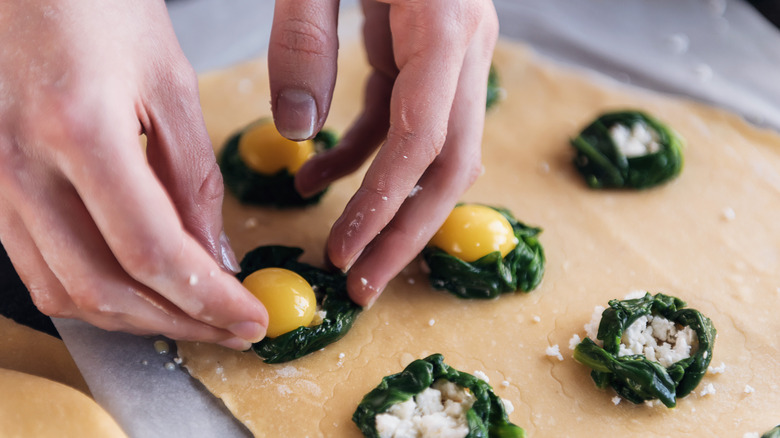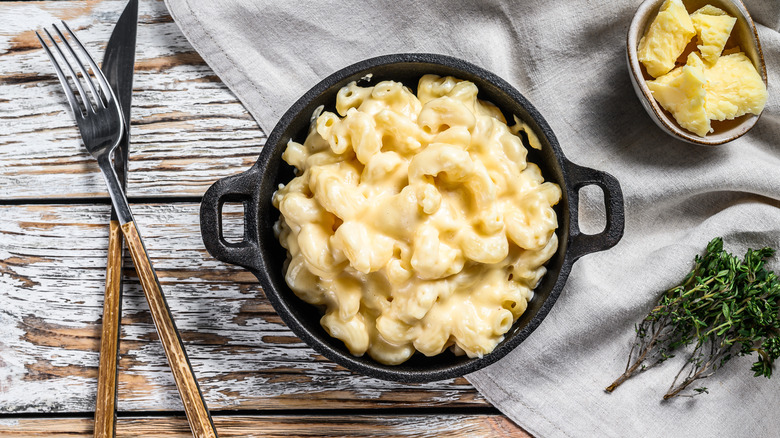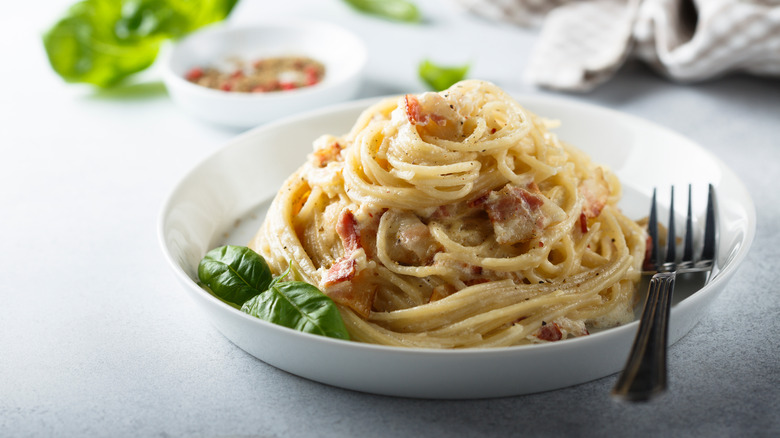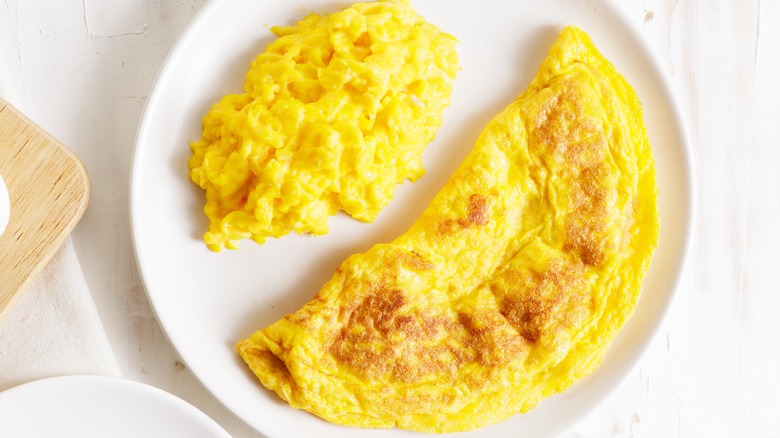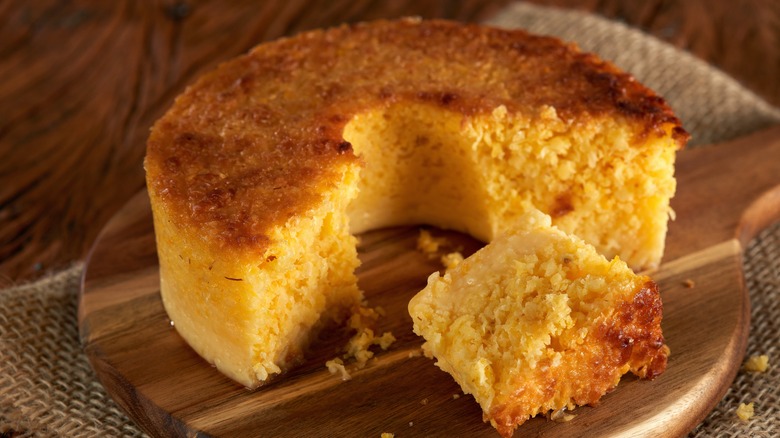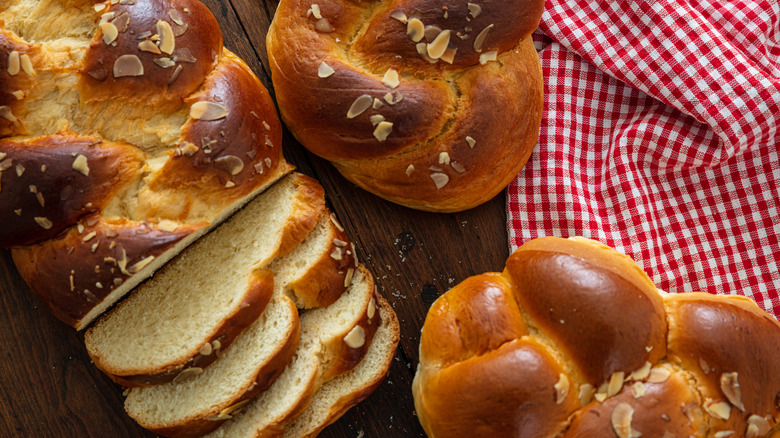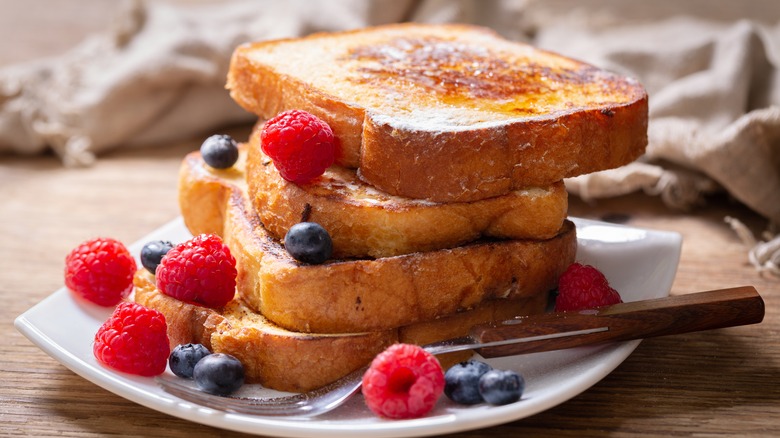What To Do With Leftover Egg Yolk
It is not uncommon to find a recipe that calls for just the egg white. But whether you have one leftover egg yolk or many, you may be wondering what to do with these spare yellow balls. Of course, with the ever increasing prices of eggs, you do not want to just throw them out. And why would you? Egg yolks are a valuable part of many recipes. Even though some may not require them, using egg yolks can drastically improve the quality of a meal.
Egg yolks are made up of protein and fat (via Baking Sense). Because of this, egg yolks can help bind but also add moisture to baked goods and enhance sweetness. This leads to a richer and creamier end result that is luscious. Plus, as Medical News Today points out, some studies suggest that most of the nutrients found in an egg are located in the yolks. The benefits include a boost in the immune system, lowering blood pressure, and reduced vision problems, such as cataracts. So if you find yourself with extra egg yolks, do not despair. There are plenty of ways to use up their liquid gold.
Add it to a dough
Eggs are commonly used in dough. Not only do they act as a liquid ingredient, but they act as a binder as well, working to hold the whole thing together in perfect harmony. As Baking Kneads points out, while the white is there to act predominantly as the liquid, the yolk helps to add fat. Therefore, adding extra egg yolks to the dough makes a fattier, more decadent dough, and as Baking Kneads notes, it can also create a smoother one. Additionally, since egg yolks also help bind liquid ingredients and sugar, your dough will be moist and sweet (via Baking Sense).
With all of this, we hope we have convinced you to try giving dough an extra shot of egg yolk. This can be especially helpful when making cookie dough that you want to be soft, not hard and crunchy. Leftover egg yolks will seriously upgrade your chocolate chip cookies and bring them up to the next level. So if you love chewy and fluffy cookies, add an extra egg yolk.
Make a custard
An easy way to use up a larger quantity of egg yolks is to make a custard. Custard is an egg-based dish whose premier distinction is that it is rich and creamy (via Crafty Baking). That sounds like a perfect contender for extra egg yolks, right? That is because, in addition to other ingredients such as cream or thickeners, egg yolks play a crucial component, with many recipes using only egg yolks to achieve the desired results.
Basic vanilla custard is, on its own, delicious. But custard can be used in a variety of ways. It is the foundation for desserts like creme brulee and flan. It can be used to make cheesecake and custard pies. Custards are also the basis for pastry creams, which are used to fill cakes and other pastries. Whether you are eating it on its own or using it as part of a larger group, the custard is sure to use up those extra eggs.
And, what is more, even though custard may elicit the image of sweets, it can actually be used to make savory dishes as well. Chawanmushi is a Japanese savory custard, and quiche uses a custard base. Even if your custard recipe calls for whole eggs, adding extra egg yolks will help both those signature custard textures.
Make cured egg yolks
When people think of cured foods, they typically think of cured meats such as pepperoni and prosciutto. However, what many people do not realize is that you can cure your own foods at home without much difficulty, and you are not limited to meats.
According to Volpi foods, curing is the process of preservation that removes moisture and bacteria from the intended food. This can be done simply and easily with just salt or a combination of salt and sugar. To make Cured Egg Yolks, you will need egg yolks that are fully intact and retain their round shape with no oozing. The yolks are then placed in the salt or sugar and salt mixture and left in the fridge to sit. After a week, they are nice and dry and can be rinsed of residual salt and placed in a low oven to dry. Not only will the process use up extra egg yolks, but it will also help preserve your egg yolks for later use.
Now that you have cured eggs, though, what to do with them? Cured egg yolks are delicious grated over pasta or vegetables. They can be eaten on sandwiches. They will add a light yolky flavor to things and add fatty richness, much like cheese. If you are not using egg yolks for anything else, this is an easy and versatile option.
Make a creamy sauce
Did you know some of your favorite condiments are made using egg yolks? The most popular condiment in the United States, mayonnaise, is made using egg yolks as a main ingredient (via Statista), and it is not the only one. Many kinds of aioli use egg yolks as an emulsifying agent (via Britannica) and, as discussed, egg yolks are the part of the egg that helps with bonding (via Baking Sense). Additionally, hollandaise sauce, the classic pairing for breakfast eggs Benedict, is made using egg yolks. Then there is hollandaise's cousin, Béarnaise sauce.
All of these sauces are known for their luxurious texture, which will add a richness to any dish, and they can all be made at home. If you have extra yolks and do not want to be stuck making a whole dish, make a creamy sauce. They can make just about any dish more interesting and you can pick which sauce you make based on your current needs. Flavors can be added and, in the end, you will have a velvety smooth sauce to enhance any dish.
Add it to potatoes
Potatoes are pretty much universally loved, and can be made in so many ways it can be impossible to try them all. But one way you definitely should try them is with some added egg yolk.
The easiest way to do this is to add them to your next batch of mashed potatoes. As McCormick explains, adding egg yolks to mashed potatoes can add decadence to your potatoes without the addition of more conventional dairy options. The egg yolk will not add an eggy flavor or color. Instead, it will act as the magical emulsifier that it is and bind everything together to give it a rich taste and feel. The best part is you do not even need a recipe, just add it to your hot potatoes and mix vigorously.
Another classic egg yolk and potato dish is duchess potatoes. If you are looking for the same great taste but an elevated presentation, duchess potatoes start with an egg yolk mashed potato, then are piped onto a baking sheet in decorative swirls and baked to create beautiful bite sized potato pillows. Whether you want quick and easy or an impressive and fancy dish, add that extra egg yolk to your potatoes, and you will not be sorry.
Make egg yolk pasta
Making fresh pasta at home can be a labor of love, but considering the taste difference between fresh pasta and boxed, we think it is worth it. When making pasta at home, the ingredients are usually fairly simple, including flour, salt, eggs, and occasionally water. This will give you a basic dough. But if you do not want basic, try playing with the egg yolk ratio and either substitute in extra yolks or eliminate the whites entirely for an entirely egg yolk-based pasta.
Egg yolk pasta will offer a deeper yellow color and a softer yet elastic texture. Extra egg yolks in the pasta are great, especially when making stuffed kinds of pasta like ravioli. To kick the egg yolk game up even further, why not try an egg yolk-filled ravioli? This will make use of egg yolks in both your pasta dough and in the pasta itself. This will create a unique dish and will use up to a dozen extra egg yolks. If using an entire egg yolk in a filled pasta feels like too much, though, try the basic egg yolk pasta and see how you like it.
Add a creamy element to your mac and cheese
If making your own pasta is not in the cards, that's okay, there's no shame in using boxed pasta. There are other ways to incorporate egg yolks into your next pasta dish while still using the boxed stuff. As Mashed explains in their One-Pot Mac and Cheese Recipe adding an egg yolk to a simple macaroni and cheese recipe is the best way to elevate it.
The reason comes back to egg yolks' extraordinary abilities as an emulsifier. While many recipes rely on flour and roux to help emulsify, if you use an egg yolk, you do not need that ingredient. The egg yolk helps bind to the cheese oils and hold it all together, instead of the oil separating during the cooking process. This helps give an aesthetically pleasing mac and cheese and also adds the fat from both the cheese and the egg yolk into the mix. This ultimately makes for a thick and oh-so-delicious macaroni and cheese. And the best part is that, as the name implies, this kind of mac and cheese need only dirty a single pan and does not take very long to cook. So if you have an extra egg yolk lying around, go ahead add it to your mac and cheese.
Make a pasta carbonara
Pasta and egg yolks really do seem to be a match made in heaven. If none of the other pasta options felt right to you, we have a final suggestion. Go for the classic egg yolk pasta dish: pasta carbonara.
Pasta carbonara is a dish of simple ingredients, starting with fresh hot pasta mixed with sauteed pork and grated cheese. The pièce de resistance, though, is the whole thing being mixed with eggs. This must be done quickly so the hot pasta cooks but does not curdle your eggs. Otherwise, you are eating scrambled eggs and pasta.
Pasta company Delallo explains that the key to a good carbonara is the egg-yolk-to-whole-egg ratio. Since the pivotal part of carbonara is the creamy egg sauce, it is important to get the right combination of egg yolks and whole eggs. This means using at least one extra egg yolk. Their recommended ratio is to use one whole egg and then one additional egg yolk per person for up to four people. This will give you the ideal texture creating the dreamy, creamy sauce that will coat the noodles.
Make an egg yolk omelet
If you are just now learning about egg yolk omelets due to the James Cordon egg yolk omelet controversy and are intrigued, you are in luck. Egg yolk omelets are one of the easiest ways to use up large quantities of egg yolks in a short matter of time.
Egg yolk omelets are exactly what they sound like, an omelet made using only egg yolks, not whites. They are the antithesis of the more common egg white omelet.
To make a basic egg yolk omelet, make an omelet the way you typically would, with whatever fillings you desire. But, instead of using the whole egg, use only the egg yolks. Also, make sure to account for the volume loss that occurs when you omit the egg whites. As long as allergies are not a concern though, a little egg white sneaking in will be okay.
Because egg yolks are rich and fatty, egg yolk omelets tend to be a little denser. People Magazine tried a few tricks to try and lighten them up and found that adding a bit of water gave a better volume and texture.
Add them to cake
Eggs play a critical role in the success of cakes. They bind, they moisten, and they leaven. Therefore, it is hard to make a good cake without any eggs at all, though not impossible. However, if you find yourself with extra egg yolks, often your cake can be significantly improved with their addition.
Egg yolks are the emulsifier of the egg, which means when added to cakes, they help to hold everything together, including water and fat, which are typically opposites (via Baking sense). So they will help prevent your oil and water from separating. Additionally, they will incorporate their own fat, adding to the moisture and giving structure to the cake.
In their experiments, Baking Sense tried various combinations of egg yolks-to-whites ratios when it came to cake. They found egg yolks added a noticeable yellow hue to the cakes. In addition, the cake made from only egg yolks did not rise as high but was incredibly soft. While not necessarily ideal for pound cake, when a higher proportion of egg yolks were used in conjunction with whole eggs, a soft and moist cake was produced.
In fact, you do not need to be cooking from scratch to reap the benefits. Rachel Ray recommends adding extra egg yolks to boxed cake mix to give it that extra punch. So no matter how you make your cake, remember to throw in that leftover egg yolk.
Add it to bread
A loaf of basic bread is delicious and serves many wonderful purposes. These breads are typically made from just flour, water, yeast, and salt. However, to take it a step further, there are other kinds of bread, known as enriched bread, which have added ingredients such as sugar, butter, milk, and yes — eggs (via MasterClass). As Masterclass explains, bread made with eggs, particularly egg yolks, works against gluten forming rigid bonds, so instead, you end up with soft squishy bread.
Busby's Bakery continues that egg bread offers a richer flavor and often has a longer shelf life. The egg yolks work to add a pleasant "eggy" flavor and result in a thicker, smoother dough. In fact, it is likely some of your favorite bread is made from egg dough, such as challah and brioche (via MasterClass). Both breads offer a soft, sponge-like consistency and are lightly flavorful. If you are looking for a way to intensify the best parts of egg bread, try a recipe like this challah, which utilizes extra egg yolks.
Add it to French toast
Finally, if you find yourself with leftover bread and leftover egg yolks, why not kill two birds with one stone and make French toast? Traditionally French toast is made using whole eggs to coat old or stale bread and revitalize it into a new treat. This is one of the best ways to use up bread and prevent it from going bad. But if you find yourself with extra egg yolks, you can add them into the mix as well.
One of the nice things about French toast is that it is not particularly delicate. Therefore, adding an extra egg yolk to your usual French toast recipe is not going to negatively affect the proportions, but it will add an extra hit of fat and binding to the whole thing. That being said, because egg yolks are basically a simple custard bread, it makes sense to omit the whites altogether. So consider instead making an entire egg yolk French toast. This will give you a decadent French toast worthy of even the fanciest of brunches — though we suspect you may want to keep all of it for yourself.
